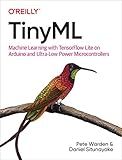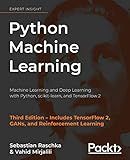Best TensorFlow Learning Resources to Buy in December 2025

Hands-On Machine Learning with Scikit-Learn, Keras, and TensorFlow



Deep Learning with TensorFlow and Keras: Build and deploy supervised, unsupervised, deep, and reinforcement learning models, 3rd Edition



TinyML: Machine Learning with TensorFlow Lite on Arduino and Ultra-Low-Power Microcontrollers



Hands-On Machine Learning with Scikit-Learn, Keras, and TensorFlow: Concepts, Tools, and Techniques to Build Intelligent Systems



Python Machine Learning: Machine Learning and Deep Learning with Python, scikit-learn, and TensorFlow 2, 3rd Edition



Learning Deep Learning: Theory and Practice of Neural Networks, Computer Vision, Natural Language Processing, and Transformers Using TensorFlow



Hands-On Machine Learning with Scikit-Learn and TensorFlow: Concepts, Tools, and Techniques to Build Intelligent Systems



Understanding Deep Learning: Building Machine Learning Systems with PyTorch and TensorFlow: From Neural Networks (CNN, DNN, GNN, RNN, ANN, LSTM, GAN) to Natural Language Processing (NLP)



Machine Learning with PyTorch and Scikit-Learn: Develop machine learning and deep learning models with Python


In TensorFlow, you can use the tf.math.unsorted_segment_sum function to perform group-by operations. This function takes three arguments: the data to be segmented, the segment indices, and the number of segments. You can use this function to group data based on a key and perform operations such as sum, mean, max, etc. within each group.
To use group-by operations in TensorFlow, you first need to create a tensor of segment indices that indicate which group each element belongs to. Then, you can use the tf.math.unsorted_segment_sum function to apply the desired operation within each group.
For example, to calculate the sum of each group in a tensor data based on the segment indices segment_indices, you can use the following code:
import tensorflow as tf
data = tf.constant([1, 2, 3, 4, 5]) segment_indices = tf.constant([0, 1, 0, 1, 2])
num_segments = tf.reduce_max(segment_indices) + 1 group_sums = tf.math.unsorted_segment_sum(data, segment_indices, num_segments)
print(group_sums)
This will output the sum of each group in the tensor data based on the segment indices provided. You can also use other operations like tf.math.unsorted_segment_mean, tf.math.unsorted_segment_max, etc. to perform different group-by operations in TensorFlow.
What is the best way to debug group-by operations in TensorFlow?
One of the best ways to debug group-by operations in TensorFlow is to use the tf.debugging.experimental.enable_dump_debug_info method. This method allows you to dump debugging information about the tensors involved in group-by operations, including their shape, values, and metadata. This can help you identify any issues with the group-by operation and troubleshoot them effectively.
You can also use tf.debugging.assert_equal to check the correctness of the group-by operation by comparing the expected values with the actual output. Additionally, you can print out intermediate values and tensors using tf.print to understand what is happening at each step of the group-by operation.
Furthermore, you can use the TensorFlow Debugger (tfdbg) tool to debug group-by operations interactively. tfdbg allows you to set breakpoints, inspect tensors, and step through the execution of the TensorFlow graph, making it easier to identify and fix any issues with group-by operations.
Overall, using a combination of these methods can help you effectively debug group-by operations in TensorFlow and ensure the correctness of your code.
How to filter groups based on conditions in TensorFlow group-by operations?
In TensorFlow, you can use the tf.data.Dataset.filter() method to filter groups based on conditions in group-by operations. Here's how you can filter groups based on specific conditions:
- Define a function that returns a boolean value based on the condition you want to filter by. This function will be used as the argument to the filter() method.
def filter_condition(group): # Define your condition here # For example, filter groups that have a sum greater than a certain threshold return tf.reduce_sum(group) > threshold
- Use the filter() method along with the function defined in step 1 to filter groups in your dataset.
dataset = tf.data.Dataset.from_tensor_slices(data) filtered_dataset = dataset.batch(batch_size).filter(filter_condition)
- Iterate over the filtered dataset to access the filtered groups.
for group in filtered_dataset: # Process the filtered groups here
By following these steps, you can filter groups in TensorFlow based on specific conditions in group-by operations.
What is the significance of order in group-by operations in TensorFlow?
The significance of order in group-by operations in TensorFlow is that it determines how the input data is organized and aggregated before applying any further operations. The order in which the data is grouped can affect the final output of the group-by operation, as different orders can lead to different aggregation results. Therefore, it is important to consider the order in group-by operations to ensure that the data is grouped and aggregated in the desired way.
What is the memory consumption of group-by operations in TensorFlow?
The memory consumption of group-by operations in TensorFlow can vary depending on the size of the input data and the complexity of the operation. In general, group-by operations in TensorFlow can be memory-intensive as they involve grouping and aggregating data based on certain criteria, which can require storing intermediate results in memory. It is recommended to be cautious with the memory consumption when using group-by operations on large datasets and consider optimizing the operation to reduce memory usage.
